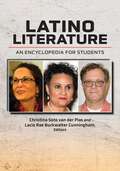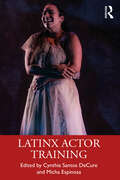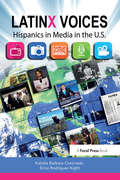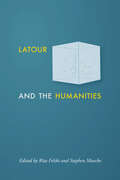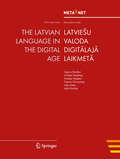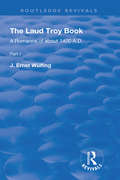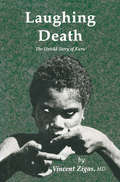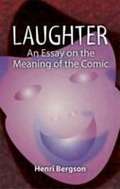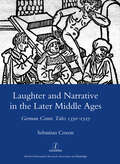- Table View
- List View
Latino Literature: An Encyclopedia for Students
by Christina Soto van der Plas and Lacie Rae Buckwalter CunninghamOffers a comprehensive overview of the most important authors, movements, genres, and historical turning points in Latino literature.More than 60 million Latinos currently live in the United States. Yet contributions from writers who trace their heritage to the Caribbean, Central and South America, and Mexico have and continue to be overlooked by critics and general audiences alike. Latino Literature: An Encyclopedia for Students gathers the best from these authors and presents them to readers in an informed and accessible way. Intended to be a useful resource for students, this volume introduces the key figures and genres central to Latino literature. Entries are written by prominent and emerging scholars and are comprehensive in their coverage of the 19th, 20th, and 21st centuries. Different critical approaches inform and interpret the myriad complexities of Latino literary production over the last several hundred years. Finally, detailed historical and cultural accounts of Latino diasporas also enrich readers' understandings of the writings that have and continue to be influenced by changes in cultural geography, providing readers with the information they need to appreciate a body of work that will continue to flourish in and alongside Latino communities.
Latino Literature: An Encyclopedia for Students
Offers a comprehensive overview of the most important authors, movements, genres, and historical turning points in Latino literature.More than 60 million Latinos currently live in the United States. Yet contributions from writers who trace their heritage to the Caribbean, Central and South America, and Mexico have and continue to be overlooked by critics and general audiences alike. Latino Literature: An Encyclopedia for Students gathers the best from these authors and presents them to readers in an informed and accessible way. Intended to be a useful resource for students, this volume introduces the key figures and genres central to Latino literature. Entries are written by prominent and emerging scholars and are comprehensive in their coverage of the 19th, 20th, and 21st centuries. Different critical approaches inform and interpret the myriad complexities of Latino literary production over the last several hundred years. Finally, detailed historical and cultural accounts of Latino diasporas also enrich readers' understandings of the writings that have and continue to be influenced by changes in cultural geography, providing readers with the information they need to appreciate a body of work that will continue to flourish in and alongside Latino communities.
Latino Literature in America (Literature as Windows to World Cultures)
by Bridget KevaneThere is growing awareness of the tremendous impact Latino writers have had on the recent literary scene, yet not all readers have the background to fully appreciate the merits and meanings of works like House on Mango Street, Line of the Sun, Bless Me Ultima, and In the Time of Butterflies. Offering analysis of their most important, popular, and frequently assigned fictional works, this book surveys the contributions of eight notable Latino writers: Julia Alvarez, Rodolfo Anaya, Sandra Cisneros, Junot Díaz, Christina Garía, Oscar Hijuelos, Ortiz Cofer, and Ernesto Quiñonez.Each chapter gives biographical background on the author and clear literary analysis of the selected works, including a concise plot synopsis. Delving into the question of cultural identity, each work is carefully examined not only in terms of its literary components, but also with regard to the cultural background and historical context. This book illuminates such themes as acculturation, generational differences, immigration, assimilation, and exile. Language, religion, and gender issues are explored against the cultural backdrop, along with the social impact of such historical events as Operation Bootstrap in Puerto Rico, the early days of Castro's Cuba, and the Trujillo Dictatorship in the Dominican Republic. Students and teachers will find their reading experiences of U.S. Latino works enriched with the literary and cultural perspectives offered here. A list of additional suggested reading is included.
A Latino Reading of Race, Kinship, and the Empire: John’s Prologue
by Rodolfo Galvan Estrada IIIThis book provides a Latino reading of John’s prologue with special attention to how the themes of race, kinship, and the empire are part of the gospel’s racial rhetoric. By drawing from the insights of Latinx texts and theology, this book reveals how the prologue provides a lens to read the entire gospel with a keen awareness of Jesus’s engagement with people groups—from his own family to the Roman authorities. The prologue participates in the gospel’s racial rhetoric by shaping the reader’s racial imagination even before a person enters the narrative. By doing so, Jesus’s identity becomes constructed and defined through racial rhetoric since the opening verses of John’s gospel.
Latinx Actor Training
by Cynthia Santos DeCure Micha EspinosaLatinx Actor Training presents essays and pioneering research from leading Latinx practitioners and scholars in the United States to examine the history and future of Latino/a/x/e actor training practices and approaches. Born out of the urgent need to address the inequities in academia and the industry as Latinx representation on stage and screen remains disproportionately low despite population growth; this book seeks to reimagine and restructure the practice of actor training by inviting deep investigation into heritage and identity practices. Latinx Actor Training features contributions covering current and historical acting methodologies, principles, and training, explorations of linguistic identity, casting considerations, and culturally inclusive practices that aim to empower a new generation of Latinx actors and to assist the educators who are entrusted with their training. This book is dedicated to creating career success and championing positive narratives to combat pervasive and damaging stereotypes. Latinx Actor Training offers culturally inclusive pedagogies that will be invaluable for students, practitioners, and scholars interested in the intersections of Latinx herencia (heritage), identity, and actor training.
Latinx Actor Training
by Cynthia Santos DeCure Micha EspinosaLatinx Actor Training presents essays and pioneering research from leading Latinx practitioners and scholars in the United States to examine the history and future of Latino/a/x/e actor training practices and approaches. Born out of the urgent need to address the inequities in academia and the industry as Latinx representation on stage and screen remains disproportionately low despite population growth; this book seeks to reimagine and restructure the practice of actor training by inviting deep investigation into heritage and identity practices. Latinx Actor Training features contributions covering current and historical acting methodologies, principles, and training, explorations of linguistic identity, casting considerations, and culturally inclusive practices that aim to empower a new generation of Latinx actors and to assist the educators who are entrusted with their training. This book is dedicated to creating career success and championing positive narratives to combat pervasive and damaging stereotypes. Latinx Actor Training offers culturally inclusive pedagogies that will be invaluable for students, practitioners, and scholars interested in the intersections of Latinx herencia (heritage), identity, and actor training.
Latinx Literature Now: Between Evanescence and Event (Literatures of the Americas)
by Ricardo L. OrtizLatinx Literature Now engages with a diverse collection of works in Latinx literary studies, critical theory, and the philosophy of history, as well as a wide range of Latinx literary texts, in order to offer readers an alternative model of how Latinx literary scholarship and Latinx literary criticism might go about doing their work. It encourages practitioners in the field to reflect on literature and latinidad together as both parallel and intersecting historical-cultural formations, and to assess from that reflection how literary works might uniquely condition and depict latinidad as something other than a fixed, stable category of identity, as instead an ongoing process of becoming, one always capable of promise, but also always vulnerable to risk, threat, precarity and even disappearance: that is, as always more prone to the performative flash of an evanescence than to the ontological solidity of an event.
LatinX Voices: Hispanics in Media in the U.S
by Katie Coronado Erica KightLatinX Voices is the first undergraduate textbook that includes an overview of Hispanic/LatinX Media in the U.S. and gives readers an understanding of how media in the United States has transformed around this audience. Based on the authors’ professional and research experience, and teaching broadcast media courses in the classroom, this text covers the evolving industry and offers perspective on topics related to Latin-American areas of interest. With professional testimonials from those who have left their mark in print, radio, television, film and new media, this collection of chapters brings together expert voices in Hispanic/LatinX media from across the U.S., and explains the impact of this population on the media industry today.
LatinX Voices: Hispanics in Media in the U.S
by Katie Coronado Erica KightLatinX Voices is the first undergraduate textbook that includes an overview of Hispanic/LatinX Media in the U.S. and gives readers an understanding of how media in the United States has transformed around this audience. Based on the authors’ professional and research experience, and teaching broadcast media courses in the classroom, this text covers the evolving industry and offers perspective on topics related to Latin-American areas of interest. With professional testimonials from those who have left their mark in print, radio, television, film and new media, this collection of chapters brings together expert voices in Hispanic/LatinX media from across the U.S., and explains the impact of this population on the media industry today.
Latour and the Humanities
by Rita Felski Stephen MueckeIn recent years, defenses of the humanities have tended to argue along predictable lines: the humanities foster empathy, the humanities encourage critical thinking, the humanities offer a counterweight to the cold calculations of the natural and social sciences. The essays in Latour and the Humanities take a different approach. Exploring the relevance of theorist Bruno Latour's work, they argue for attachments and entanglements between the humanities and the sciences while looking closely at the interests, institutions, and intellectual projects that shape the humanities within and beyond the university. The collection, which is written by a group of highly distinguished scholars from around the world, is divided into two sections. In the first part, authors engage in depth with Latour's work while also rethinking the ties between the humanities and the sciences. Essays argue for greater attention to the nonhuman world, the urgency of climate change, and more nuanced views of universities as institutions. The second half of the volume contains essays that reflect on Latour's influence on the practices of specific disciplines, including art, the digital humanities, film studies, and political theory.Inspiring conversation about the relevance of actor-network-theory for research and teaching in the humanities, Latour and the Humanities offers a substantial introduction to Latour's work while discussing the humanities without falling back on the genres of either the sermon or the jeremiad. This volume will be of interest to all those searching for fresh perspectives on the value and importance of humanistic disciplines and thought.Contributors: David J. Alworth, Anders Blok, Claudia Breger, Dipesh Chakrabarty, Yves Citton, Steven Connor, Gerard de Vries, Simon During, Rita Felski, Francis Halsall, Graham Harman, Antoine Hennion, Casper Bruun Jensen, Bruno Latour, Heather Love, Patrice Maniglier, Stephen Muecke, Barbara Herrnstein Smith, Nigel Thrift, Michael Witmore
Latour and the Humanities
by Rita Felski and Stephen MueckeIn recent years, defenses of the humanities have tended to argue along predictable lines: the humanities foster empathy, the humanities encourage critical thinking, the humanities offer a counterweight to the cold calculations of the natural and social sciences. The essays in Latour and the Humanities take a different approach. Exploring the relevance of theorist Bruno Latour's work, they argue for attachments and entanglements between the humanities and the sciences while looking closely at the interests, institutions, and intellectual projects that shape the humanities within and beyond the university. The collection, which is written by a group of highly distinguished scholars from around the world, is divided into two sections. In the first part, authors engage in depth with Latour's work while also rethinking the ties between the humanities and the sciences. Essays argue for greater attention to the nonhuman world, the urgency of climate change, and more nuanced views of universities as institutions. The second half of the volume contains essays that reflect on Latour's influence on the practices of specific disciplines, including art, the digital humanities, film studies, and political theory.Inspiring conversation about the relevance of actor-network-theory for research and teaching in the humanities, Latour and the Humanities offers a substantial introduction to Latour's work while discussing the humanities without falling back on the genres of either the sermon or the jeremiad. This volume will be of interest to all those searching for fresh perspectives on the value and importance of humanistic disciplines and thought.Contributors: David J. Alworth, Anders Blok, Claudia Breger, Dipesh Chakrabarty, Yves Citton, Steven Connor, Gerard de Vries, Simon During, Rita Felski, Francis Halsall, Graham Harman, Antoine Hennion, Casper Bruun Jensen, Bruno Latour, Heather Love, Patrice Maniglier, Stephen Muecke, Barbara Herrnstein Smith, Nigel Thrift, Michael Witmore
The Latvian Language in the Digital Age (White Paper Series)
by Georg Rehm Hans UszkoreitThis white paper is part of a series that promotes knowledge about language technology and its potential. It addresses educators, journalists, politicians, language communities and others. The availability and use of language technology in Europe varies between languages. Consequently, the actions that are required to further support research and development of language technologies also differ for each language. The required actions depend on many factors, such as the complexity of a given language and the size of its community. META-NET, a Network of Excellence funded by the European Commission, has conducted an analysis of current language resources and technologies. This analysis focused on the 23 official European languages as well as other important national and regional languages in Europe. The results of this analysis suggest that there are many significant research gaps for each language. A more detailed expert analysis and assessment of the current situation will help maximise the impact of additional research and minimize any risks. META-NET consists of 54 research centres from 33 countries that are working with stakeholders from commercial businesses, government agencies, industry, research organisations, software companies, technology providers and European universities. Together, they are creating a common technology vision while developing a strategic research agenda that shows how language technology applications can address any research gaps by 2020.
The Laud Troy Book: A Romance of about 1400 A.D. (Routledge Revivals)
by J. Ernst WülfingFirst published in 1902, this volume was edited from the unique manuscript, Laud Misc. 595, in the Bodleian Library, Oxford. The manuscript dates to the early 15th century, though it cannot be the original. Parts I and II of this Middle-English text are republished here as one volume, accompanied with glosses though without introduction.
The Laud Troy Book: A Romance of about 1400 A.D. (Routledge Revivals)
by J. Ernst WülfingFirst published in 1902, this volume was edited from the unique manuscript, Laud Misc. 595, in the Bodleian Library, Oxford. The manuscript dates to the early 15th century, though it cannot be the original. Parts I and II of this Middle-English text are republished here as one volume, accompanied with glosses though without introduction.
Laughing and Weeping in Early Modern Theatres (Studies in Performance and Early Modern Drama)
by Matthew SteggleDid Shakespeare's original audiences weep? Equally, while it seems obvious that they must have laughed at plays performed in early modern theatres, can we say anything about what their laughter sounded like, about when it occurred, and about how, culturally, it was interpreted? Related to both of these problems of audience behaviour is that of the stage representation of laughing, and weeping, both actions performed with astonishing frequency in early modern drama. Each action is associated with a complex set of non-verbal noises, gestures, and cultural overtones, and each is linked to audience behaviour through one of the axioms of Renaissance dramatic theory: that weeping and laughter on stage cause, respectively, weeping and laughter in the audience. This book is a study of laughter and weeping in English theatres, broadly defined, from around 1550 until their closure in 1642. It is concerned both with the representation of these actions on the stage, and with what can be reconstructed about the laughter and weeping of theatrical audiences themselves, arguing that both actions have a peculiar importance in defining the early modern theatrical experience.
Laughing and Weeping in Early Modern Theatres (Studies in Performance and Early Modern Drama)
by Matthew SteggleDid Shakespeare's original audiences weep? Equally, while it seems obvious that they must have laughed at plays performed in early modern theatres, can we say anything about what their laughter sounded like, about when it occurred, and about how, culturally, it was interpreted? Related to both of these problems of audience behaviour is that of the stage representation of laughing, and weeping, both actions performed with astonishing frequency in early modern drama. Each action is associated with a complex set of non-verbal noises, gestures, and cultural overtones, and each is linked to audience behaviour through one of the axioms of Renaissance dramatic theory: that weeping and laughter on stage cause, respectively, weeping and laughter in the audience. This book is a study of laughter and weeping in English theatres, broadly defined, from around 1550 until their closure in 1642. It is concerned both with the representation of these actions on the stage, and with what can be reconstructed about the laughter and weeping of theatrical audiences themselves, arguing that both actions have a peculiar importance in defining the early modern theatrical experience.
Laughing Atoms, Laughing Matter: Lucretius’ De Rerum Natura and Satire
by T.H.M. Gellar-GoadLaughing Atoms, Laughing Matter: Lucretius' De Rerum Natura and Satire offers the first comprehensive examination of Roman epic poet Lucretius’ engagement with satire. Author T. H. M. Gellar-Goad argues that what has often been understood as an artfully persuasive exposition of Epicurean philosophy designed to convert the uninitiated is actually a mimesis of the narrator’s attempt to effect such a conversion on his internal narrative audience—a performance for the true audience of the poem, whose members take pleasure from uncovering the literary games and the intertextual engagement that the performance entails. Gellar-Goad aims to track De Rerum Natura along two paths of satire: first, the broad boulevard of satiric literature from the beginnings of Greek poetry to the plays, essays, and broadcast media of the modern world; and second, the narrower lane of Roman verse satire, satura, beginning with early authors Ennius and Lucilius and closing with Flavian poet Juvenal. Lucilius is revealed as a major, yet overlooked, influence on Lucretius. By examining how Lucretius’ poem employs the tools of satire, we gain a richer understanding of how it interacts with its purported philosophical program.
Laughing Death: The Untold Story of Kuru
by Vincent ZigasIt has been a difficult, sometimes painful, story to tell in its entirety, but I have done my best to be accurate both in facts and in dates, for I feel that l owe the truth to the many who have become valued acquaintances, and sometimes friends. All these have constantly requested more news of my "Green Dwelling" and my discovery of a fatal neurological disease previously unknown to Western medicine. This book is for them, in lieu of letters that I ought to have written and did not. It is also my concern to produce innocent amusement, unrestricted by canon or precedent, for those who require some relaxation from the fatigue generated by so many parasitic forms of life in this less than perfect world.My peers, the medical scientists, who read this will realize that this book is neither a scientific treatise, nor a balance-sheet of all the achievements and failures of medical science, but a presentation of the major implications of the factors that continually determine our medical ethics - including some of the less prizeworthy drawbacks.
Laughing Feminism: Subversive Comedy in Frances Burney, Maria Edgeworth and Jane Austen (Humor in Life & Letters) (PDF)
by Audrey BilgerAt a time when overt feminist statements could ruin a woman's reputation, comedy enabled certain authors to smuggle feminism into their writing. This work sheds light on the ways in which Frances Burney, Maria Edgeworth and Jane Austen enlisted the power of comedy in the service of feminism, and in so doing participated in one of the most important ideological movements of the last 300 years. It seeks to offer modern scholars a new look at feminist tactics as it brings to light a lost chapter in the history of comedy.
Laughing Fit to Kill: Black Humor in the Fictions of Slavery
by Glenda CarpioReassessing the meanings of "black humor" and "dark satire," Laughing Fit to Kill illustrates how black comedians, writers, and artists have deftly deployed various modes of comedic "conjuring"--the absurd, the grotesque, and the strategic expression of racial stereotypes--to redress not only the past injustices of slavery and racism in America but also their legacy in the present. Focusing on representations of slavery in the post-civil rights era, Carpio explores stereotypes in Richard Pryor's groundbreaking stand-up act and the outrageous comedy of Chappelle's Show to demonstrate how deeply indebted they are to the sly social criticism embedded in the profoundly ironic nineteenth-century fiction of William Wells Brown and Charles W. Chesnutt. Similarly, she reveals how the iconoclastic literary works of Ishmael Reed and Suzan-Lori Parks use satire, hyperbole, and burlesque humor to represent a violent history and to take on issues of racial injustice. With an abundance of illustrations, Carpio also extends her discussion of radical black comedy to the visual arts as she reveals how the use of subversive appropriation by Kara Walker and Robert Colescott cleverly lampoons the iconography of slavery. Ultimately, Laughing Fit to Kill offers a unique look at the bold, complex, and just plain funny ways that African American artists have used laughter to critique slavery's dark legacy.
Laughter: An Essay on the Meaning of the Comic
by Henri BergsonIn this great philosophical essay, Henri Bergson explores why people laugh and what laughter means. Written at the turn of the twentieth century, Laughter explores what it is in language that makes a joke funny and what it is in us that makes us laugh. One of the functions of humor, according to Bergson, is to help us retain our humanity during an age of mechanization. Like other philosophers, novelists, poets, and humorists of his era, Bergson was concerned with the duality of man and machine. His belief in life as a vital impulse, indefinable by reason alone, informs his perception of comedy as the relief we experience upon distancing ourselves from the mechanistic and materialistic. "A situation is always comic," Bergson notes, "if it participates simultaneously in two series of events which are absolutely independent of each other, and if it can be interpreted in two quite different meanings. " The philosopher's thought-provoking insights (e. g. , "It seems that laughter needs an echo. Our laughter is always the laughter of a group. ") keep this work ever-relevant as a thesis on the principles of humor.
Laughter and Awkwardness in Late Medieval England: Social Discomfort in the Literature of the Middle Ages (New Directions in Medieval Studies)
by David Watt'We live,' according to Adam Kotsko, 'in an awkward age.' While this condition may present some challenges, it may also help us to be more attuned to awkwardness in other ages. This book pairs medieval texts with twenty-first century films or television programmes to explore what the resonance between them can tell us about living together in an awkward age. In this nuanced and engaging study, David Watt focuses especially, but not exclusively, on the 15th century, which seems to intervene awkwardly in the literary trajectory between Chaucer and the Renaissance. This book's hypothesis is that the social discomfort depicted and engendered by writers as diverse as Thomas Hoccleve, Margery Kempe, and Sir Thomas Malory is a feature rather than a flaw. Laughter and Awkwardness in Late Medieval England explains that these authors have a great deal in common with other fifteenth-century authors, who generated embodied experiences of social discomfort in a range of genres by adopting and adapting literary techniques used by their predecessors and successors in slightly different ways. Like the twenty-first century texts with which they are paired, the late-medieval texts that feature in this book use the relationship between laughter and awkwardness to ask what it means to live with each other and how we can learn to live with ourselves.
Laughter and Awkwardness in Late Medieval England: Social Discomfort in the Literature of the Middle Ages (New Directions in Medieval Studies)
by David Watt'We live,' according to Adam Kotsko, 'in an awkward age.' While this condition may present some challenges, it may also help us to be more attuned to awkwardness in other ages. This book pairs medieval texts with twenty-first century films or television programmes to explore what the resonance between them can tell us about living together in an awkward age. In this nuanced and engaging study, David Watt focuses especially, but not exclusively, on the 15th century, which seems to intervene awkwardly in the literary trajectory between Chaucer and the Renaissance. This book's hypothesis is that the social discomfort depicted and engendered by writers as diverse as Thomas Hoccleve, Margery Kempe, and Sir Thomas Malory is a feature rather than a flaw. Laughter and Awkwardness in Late Medieval England explains that these authors have a great deal in common with other fifteenth-century authors, who generated embodied experiences of social discomfort in a range of genres by adopting and adapting literary techniques used by their predecessors and successors in slightly different ways. Like the twenty-first century texts with which they are paired, the late-medieval texts that feature in this book use the relationship between laughter and awkwardness to ask what it means to live with each other and how we can learn to live with ourselves.
Laughter and Narrative in the Later Middle Ages: German Comic Tales C.1350-1525
by Sebastian CoxonIn contrast to the vernacular literary traditions of France, Italy and England, comic tales in verse flourished in late medieval Germany, providing bawdy entertainment for larger audiences of public recitals as well as for smaller numbers of individual readers. In a sustained close analysis Sebastian Coxon explores both the narrative design and fundamental thematic preoccupations of these short texts. A distinctively performative tradition of pre-modern narrative literature emerges which invited its recipients to think, learn and above all to laugh in a number of different ways.
Laughter and Narrative in the Later Middle Ages: German Comic Tales C.1350-1525
by Sebastian CoxonIn contrast to the vernacular literary traditions of France, Italy and England, comic tales in verse flourished in late medieval Germany, providing bawdy entertainment for larger audiences of public recitals as well as for smaller numbers of individual readers. In a sustained close analysis Sebastian Coxon explores both the narrative design and fundamental thematic preoccupations of these short texts. A distinctively performative tradition of pre-modern narrative literature emerges which invited its recipients to think, learn and above all to laugh in a number of different ways.
